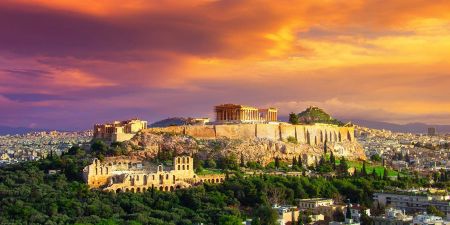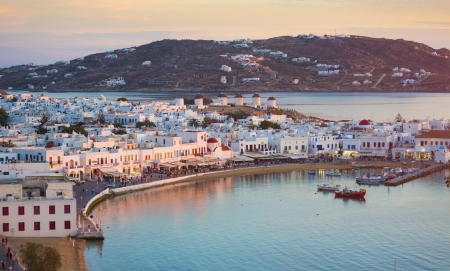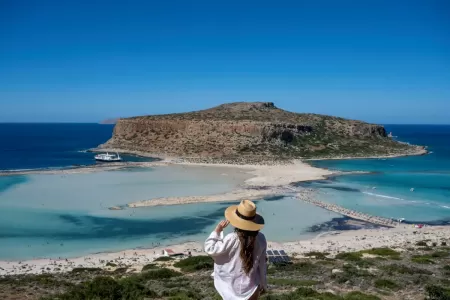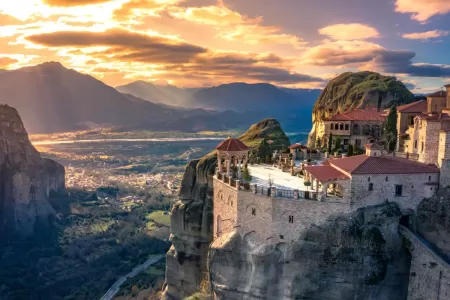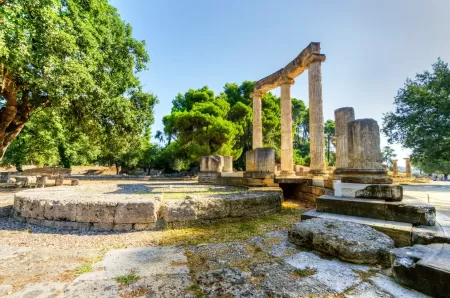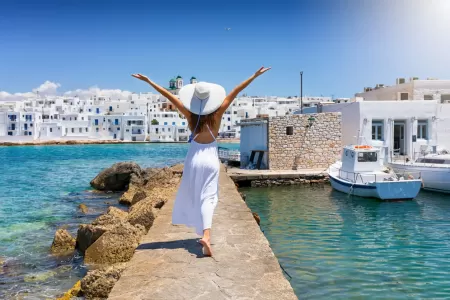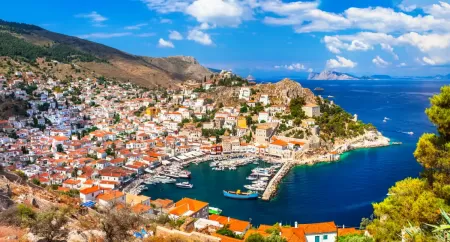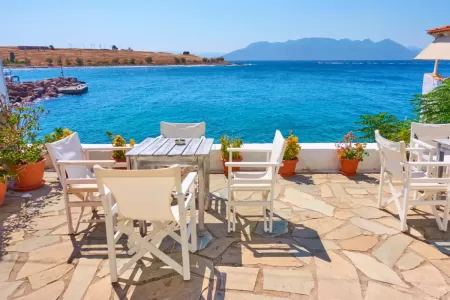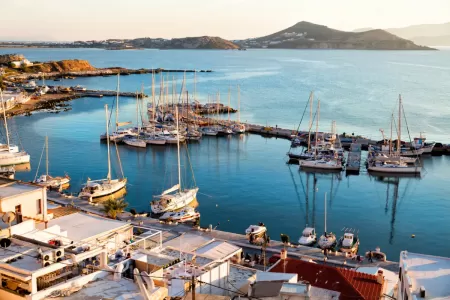Your First Time in Mykonos Greece: Essential Tips I Wish I Knew Earlier

Mykonos ranks as Greece's second most visited island after Santorini. This beautiful destination earned two nicknames: "The Island of the Winds" and the "Ibiza of Greece." The XLSIOR festival alone draws 30,000 party-goers, which might overwhelm first-time visitors. Despite its compact size of 85.5 square kilometers, Mykonos boasts 25 unique beaches that range from the bustling Paradise Beach to the quiet Agios Sostis.
The peak season runs from June through September, with temperatures reaching 27°C (80.6°F). Visitors should expect larger crowds and higher hotel rates during these months. The island offers more than just its famous beach parties until dawn. Cultural enthusiasts can discover the nearby UNESCO World Heritage site of Delos. Travelers can choose between renting a scooter for €30-€35 per day or using public transportation. These insights would have made my first trip to Mykonos much smoother.
Discover Mykonos and its Wonders with our Greece Tours!

Planning your first trip to Mykonos
A trip to Mykonos needs proper planning to make your experience unforgettable. First-time visitors should know the Greek island's unique features, from weather patterns to what they just need to pack.
Best time to visit for weather and prices
Your Mykonos vacation experience and budget largely depend on when you go. The island buzzes with activity from June through August, and temperatures hover around the mid-80s°F (29°C). These months bring peak prices and packed beaches.
September or October might work better. These months give you the best of everything - fewer crowds and warm waters that are perfect for swimming. Hotel prices also drop to reasonable levels. The weather stays nice with daily highs around 26°C (79°F).
April to early June offers another great window with pleasant temperatures. You'll find sunny days, fewer tourists, and better deals on places to stay. Late April and May are perfect if you want to focus on sightseeing instead of swimming.
Winter visitors between November and March will find the lowest prices anywhere. The catch? You'll need to deal with cooler weather - days stay in the 50s and low 60s°F (13-15°C). Many businesses shut down during winter, which leaves the island quite empty.
How many days do you really need?
The right length of stay depends on what you like to do. You'll want at least 2 nights and 1 full day. In spite of that, this barely scratches the surface of what Mykonos offers.
A complete experience takes about 4-5 days. This gives you time to check out different beaches, take a trip to Delos's sacred island, wander through Mykonos Town's winding streets, and enjoy the nightlife.
Active travelers can pack lots into a shorter stay if they plan well. People who like a more relaxed pace might want 6-7 days. This lets you mix lazy beach days with cultural activities.
What to pack for the island
The right packing list should handle warm days, possible winds, and Mykonos's stylish vibe. Here are the must-haves:
- Beachwear: You'll want 2-3 swimsuits since you'll spend lots of time at the beach
- Light clothing: Pack breathable clothes like linen shirts, shorts, light dresses, and cover-ups
- Comfortable footwear: Flat sandals work best for Mykonos' uneven streets—skip the high heels on cobblestone paths
- Wind protection: The famous Meltemi winds get chilly at night, so bring a light jacket, cardigan, or shawl
- Sun protection: You can't skip sunglasses, hats, and high-SPF sunscreen
Mykonos Town's cobblestone streets make comfortable walking shoes a must. It also helps to carry a water bottle because staying hydrated is vital in Mediterranean heat.
The island may be known for glamor, but you can pack light. The warm weather and Meltemi winds help clothes dry fast, so you can easily wash and rewear items during your stay.
How to get there and move around
Mykonos beckons travelers through two distinct gateways: sky and sea. Selecting your passage to this Cycladic treasure requires weighing convenience against experience, cost against comfort. Once ashore, navigating the island's modest dimensions presents various possibilities, each offering unique perspectives on its captivating landscapes.
Flying vs. ferry: pros and cons
The journey to Mykonos splits between aerial and maritime approaches. Flights from Athens whisk passengers across the Aegean in a mere 30 minutes, presenting the swiftest route to island pleasures. Ferry voyages, by contrast, stretch between 2.5 and 5.5 hours, varying with vessel selection.
Each transportation mode boasts distinctive qualities worth consideration:
- Flying advantages: Brief journey time, reduced vulnerability to adverse weather conditions, generally reliable arrival schedules
- Flying disadvantages: Elevated fares (particularly during summer months), restricted luggage allowances, time-consuming airport formalities
- Ferry advantages: Magnificent Aegean panoramas, freedom for onboard movement, generous baggage policies, superior amenities including dining options
- Ferry disadvantages: Extended travel duration, susceptibility to weather disruptions or cancellations, especially during winter months
Though air travel typically commands higher prices, particularly for last-minute bookings, advance reservations might secure fares as modest as €25—a worthy consideration for budget-conscious travelers.
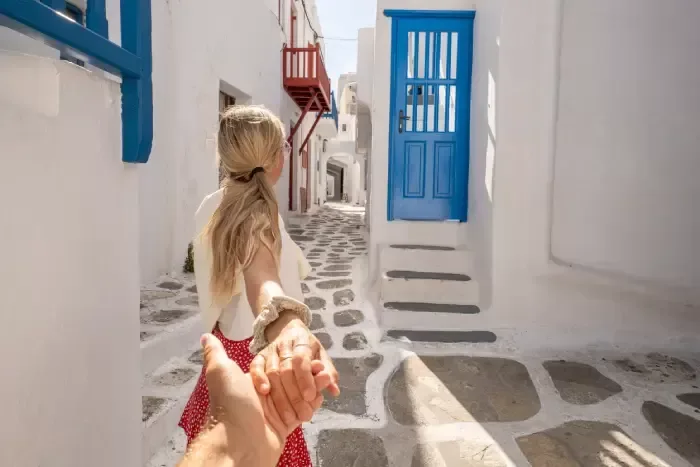
Getting from the port or airport to your hotel
Mykonos Airport sits merely 4km from Chora (Mykonos Town), offering several transfer possibilities upon arrival. Taxi services deliver passengers to town in approximately 10 minutes for around €17. Public buses provide a thriftier alternative, running from the airport to Fabrika Station at 30-60 minute intervals during high season (operating 8:15 am to 10:15 pm), with tickets costing €1.80.
Ferry passengers disembark at one of two harbors: the Old Port or New Port (Tourlos). The historic Old Port primarily welcomes smaller vessels, while the more modern New Port accommodates larger ferries and cruise ships. From these maritime gateways:
- Old Port arrivals: Find most Mykonos Town accommodations within a pleasant 5-15 minute stroll
- New Port arrivals: The Sea Bus offers convenient town connections (€2 per passenger, departing half-hourly)
Private transfers furnish a convenient though costlier option, with pre-bookable services ranging from €30-€60 depending on final destination.
Using buses, taxis, and rentals
Once established in your lodgings, island exploration becomes paramount. The KTEL bus network represents the most economical transport solution, operating from two principal stations in Mykonos Town: Fabrika and the Old Port. These hubs connect to all major beaches and attractions for approximately €2 per journey.
The island's limited taxi fleet—numbering only about 30 vehicles—creates inherent availability challenges, particularly during peak visitor periods. This scarcity drives many tourists toward vehicle rentals. Cars offer unrestricted exploration possibilities, though parking within Mykonos Town presents notable difficulties. For abbreviated distances or individual travelers, scooters and ATVs constitute popular alternatives.
Water taxis supply yet another transit option, linking Ornos and Platis Gialos beaches with southern coastal destinations including Paradise and Super Paradise. These maritime shuttles operate hourly throughout daylight hours, with full-day passes available for €20.
Your ultimate transportation choice should reflect your itinerary requirements, financial constraints, and personal comfort preferences. Whichever mode you select, advance planning—especially during the bustling summer season—ensures seamless movements as you discover the myriad delights of Mykonos, Greece.
Where to stay: choosing the right area
Your accommodation choice in Mykonos Greece, fundamentally shapes your island experience. The island presents a spectrum of options from the lively heart of town to peaceful shoreline retreats. First-time visitors particularly benefit from understanding the distinct personality each area possesses before selecting their base for exploration.
Staying in Chora vs. the beaches
Travelers face a pivotal decision: book lodging in Mykonos Town (Chora) or opt for one of the island's famed beaches. Chora concentrates the most vibrant nightlife, shopping emporiums, and dining establishments while functioning as the principal transportation nucleus. Wandering through its narrow, pedestrianized pathways bordered by pristine Cycladic architecture offers both aesthetic charm and bustling energy, particularly after darkness falls.
The southern coastline beaches benefit from natural protection against the powerful meltemi winds that sweep across the island throughout the summer months. Each southern beach possesses a unique character:
- Ornos welcomes families with its gentle swimming conditions and child-friendly atmosphere
- Platis Gialos stretches as a generous sandy expanse dotted with casual tavernas and water sports facilities
- Psarou nestles within a diminutive cove featuring tranquil waters, opulent resorts, and designer boutiques
- Paradise and Super Paradise beaches anchor the renowned party circuit that defines Mykonos nightlife
Though the island measures merely six miles in length, your accommodation selection dramatically influences your overall experience. Fortunately, an efficient bus network operates until late hours, connecting Mykonos Town with popular beaches, while water taxis link the various southern coastal destinations.
Budget, mid-range, and luxury options
Accommodation pricing fluctuates dramatically depending on location and season. Budget-conscious travelers should investigate hillside properties just beyond Mykonos Town or consider authenticity-rich Ano Mera village. Throughout the island, booking during shoulder seasons (April-June or September-October) substantially reduces rates.
Mid-range accommodations flourish in Ornos and Platis Gialos, areas offering excellent value alongside diverse dining options and reliable transportation connections. Properties such as Petinos Hotel in Platis Gialos and Matogianni Hotel in town consistently earn favorable guest reviews.
Luxury seekers discover that Mykonos increasingly emphasizes bespoke service and distinctive experiences. Notable establishments include Mykonos Blu near Psarou Beach, renowned for its timeless aesthetic and comprehensive spa facilities, alongside Cali Mykonos in the exclusive coastal enclave of Kalafati for those prioritizing privacy.
Tips for booking during high season
Securing your desired accommodation during peak months (June-August) necessitates planning 6-9 months ahead, especially for sought-after properties. Room rates may increase fourfold during high season, with availability rapidly diminishing as summer approaches.
Begin by identifying your priorities—proximity to nightlife venues, beach accessibility, or family-oriented amenities—before finalizing a location. Additionally, consider whether vehicle rental features in your plans, as this mobility makes your accommodation location less decisive.
Seasoned visitors frequently prefer establishing their base in Mykonos Town while using buses to access beaches during daylight hours, subsequently returning to savor the evening ambiance when Chora truly awakens. This approach maximizes exposure to both natural splendors and celebrated nightlife without compromising convenience.
Top things to do in Mykonos Greece
Beyond the dazzling beaches and legendary nightlife, Mykonos Greece harbors remarkable cultural and historical treasures that enhance its allure. First-time visitors quickly discover this Cycladic jewel offers memorable experiences for every temperament and interest.
Explore Little Venice and the windmills
Little Venice stands as Mykonos Town's most captivating quarter, where charming houses perch directly above the sea, their colorful facades almost kissing the waves below. Dating back to the 18th century, these distinctive dwellings originally served merchants who required direct sea access for their trade operations. Modern times have transformed many of these historic structures into atmospheric cafes and restaurants, creating an irresistible hub of activity that pulses with energy after dark.
Mere steps from this enchanting neighborhood rise the iconic windmills (Kato Mili), offering panoramic vistas across Little Venice and the picturesque harbor. These stalwart structures once served Venetian millers who harnessed the island's persistent winds to grind grain; today, they have become Mykonos' most recognizable emblem. The elevated hillside position affords visitors the perfect vantage point to absorb Mykonos Town's distinctive white skyline silhouetted against the azure Aegean.
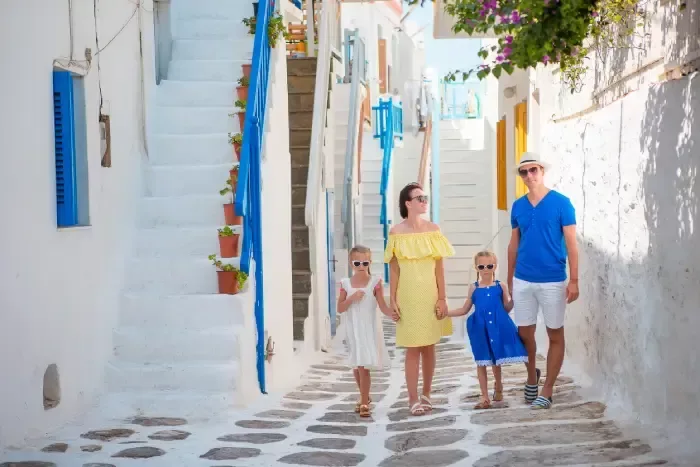
Customize Your Dream Vacation!
Get in touch with our local experts for an unforgettable journey.
Plan Your TripVisit Delos on a day trip
A modest boat journey from Mykonos Town delivers visitors to Delos, an uninhabited island of extraordinary cultural significance recognized as a UNESCO World Heritage Site. According to Greek mythology, this sacred soil witnessed the births of divine twins Apollo and Artemis.
The sea passage requires approximately 30-40 minutes, with round-trip tickets priced at €20 plus a €12 entrance fee. Once ashore, visitors wander through ancient sanctuaries, theatres, and the renowned Terrace of Lions with its weathered marble sentinels now replaced by replicas. For those seeking a deeper understanding of this archaeological wonderland, guided tours (€55 inclusive of boat passage, entrance fee, and expert narration) illuminate the historical and mythological significance embedded in these ancient stones.
Enjoy the beach party scene
Paradise and Super Paradise Beaches epitomize Mykonos' famed party culture. As afternoon sun gives way to evening stars, these coastal stretches transform into the island's most electrifying venues. Paradise Beach pulses with energy at establishments like Tropicana Beach Bar, where festivities ignite daily around 4:30 PM. Similarly, Super Paradise Beach undergoes a remarkable metamorphosis, shifting from tranquil daytime sanctuary to throbbing nightlife epicenter as darkness falls.
Try water sports at Kalafatis
Situated 15km from Mykonos Town, Kalafatis Beach hosts a sophisticated water sports facility catering to enthusiasts of all ability levels. Professional instructors ensure safe yet exhilarating experiences across numerous activities—waterskiing, wakeboarding, jet skiing, and scuba diving among them. Novices receive comprehensive land-based instruction before venturing into aquatic territory. Thrill-seekers particularly enjoy the heart-pounding tube rides and daily boat excursions led by experienced captains.
Watch the sunset from Kato Mili
Little Venice ranks among the island's most enchanting sunset vantage points. The nearby windmills, standing sentinel above the town, offer equally spellbinding perspectives as fading daylight bathes these historic structures in golden illumination. From this elevated perch, visitors witness the sky's dramatic transformation through vivid oranges and delicate pinks—a spectacle so mesmerizing that no camera truly captures its essence.

Tips to save money and avoid tourist traps
Mykonos carries a reputation as Greece's playground for the wealthy, yet seasoned travelers understand that authentic island experiences need not command exorbitant prices. Savvy visitors discover that with strategic choices, this Aegean paradise becomes remarkably more accessible.
Eat like a local at tavernas
Family-owned tavernas tucked away from tourist thoroughfares harbor the island's culinary treasures at remarkably reasonable prices. True Mykonian gastronomy reveals itself when you venture beyond your hotel's recommendations:
- Kiki's Tavern at Agios Sostis operates exclusively during lunch hours (12:30-19:00), serving exquisite grilled specialties for €10-25 in a charmingly electricity-free setting—the quality of food speaks entirely for itself
- Rizes nestled in the mountain landscape presents garden-to-table ingredients crafted into spectacular dishes priced between €10-25
- To Kafeneio tou Bakoya, positioned near the fish market, delivers genuine Greek dining experiences in a setting where local fishermen gather daily
Remember this golden rule: establishments in Little Venice or fronting popular beaches typically extract substantial premiums for often mediocre offerings. Rather, seek recommendations from hotel staff who live locally or simply observe where island residents choose to dine. Traditional dishes like moussaka and souvlaki taste infinitely better when served at fair prices in authentic settings.
Bring your own beach gear
First-time visitors routinely overlook packing beach essentials, resulting in unnecessary expenditures. Before setting foot on Mykonos' magnificent shores, ensure your luggage contains:
- Sunscreen, beach towels, and protective hats
- Reusable water containers (proper hydration proves essential under the Mediterranean sun)
- Beach bags and appropriate footwear for rocky terrain
This simple preparation eliminates costly beach rentals and impulsive purchases that invariably come attached with substantial tourist markups.
Shop smart and skip overpriced souvenirs
Tales circulate among travelers of unsuspecting guests receiving shocking bills totaling hundreds of euros following modest meals. Protect yourself with these tested strategies:
- Conduct preliminary research on standard pricing
- Request settlement after each order rather than accumulating an unmonitored tab
- Maintain a cash reserve, particularly valuable when frequenting small markets and local artisan shops
- Exercise caution around restaurants with aggressive staff attempting to secure your patronage while surrounding tables remain conspicuously vacant
The most treasured Mykonian memories inevitably spring from genuine cultural exchanges, not from establishments engineered specifically for tourists. The tavernas surrounding Ano Mera's village square offer authentic culinary experiences, worlds apart from venues catering exclusively to cruise passengers or areas dominated by foreign tourists.
Conclusion
Mykonos Greece stands as a true Mediterranean jewel, masterfully blending its sun-drenched beaches with electrifying nightlife and profound cultural heritage. The insights presented throughout this guide serve as your compass, transforming what could be an overwhelming first visit into a truly magical experience. Seasoned travelers recognize the wisdom of scheduling their Mykonos adventures during shoulder seasons (April-June or September-October)—those golden periods offering the perfect trifecta of agreeable weather, reasonable accommodation rates, and manageable crowd levels.
Though compact enough to traverse in a single day, Mykonos rewards those who choose their transportation methods strategically. Direct flights deliver expedience while ferry journeys unfold panoramic Aegean vistas—each mode presenting unique advantages tailored to your particular travel preferences and budget constraints. Equally crucial is selecting accommodations that harmonize with your vacation priorities, whether that means immersing yourself in the pulsating energy of Chora or retreating to tranquil beachfront sanctuaries.
Mykonos captivates visitors with far more than its legendary beach revelry. Cultural treasures abound, from the archaeological wonders of Delos—a UNESCO World Heritage Site just offshore—to the iconic windmills standing sentinel over Little Venice. Prudent travelers who embrace the money-saving strategies outlined here discover authentic Greek experiences without surrendering to tourist-trap pricing.
The island's extraordinary allure stems from its remarkable versatility, simultaneously satisfying diverse traveler types from nocturnal party-seekers to scholarly history enthusiasts, dedicated beach aficionados to culinary adventurers. Upon experiencing Mykonos firsthand, you'll immediately comprehend why this diminutive Cycladic paradise continues to enchant visitors decade after decade. While your inaugural visit might not be your final one, these essential insights ensure you'll extract maximum enjoyment from every precious moment spent on this enchanted Greek isle.
FAQs
Q1. When is the best time to visit Mykonos?
The best time to visit Mykonos is during the shoulder seasons of April to early June or September to October. You'll enjoy pleasant weather, fewer crowds, and more affordable accommodations while still being able to experience the island's beauty and attractions.
Q2. How many days should I spend in Mykonos?
For a comprehensive experience, plan to spend 4-5 days in Mykonos. This allows enough time to explore the beaches, visit Mykonos Town, take a day trip to Delos, and enjoy the nightlife without feeling rushed.
Q3. What are the must-visit attractions in Mykonos?
Key attractions include exploring Little Venice and the iconic windmills, visiting the UNESCO World Heritage Site of Delos, enjoying the beach party scene at Paradise and Super Paradise beaches, and watching the sunset from Kato Mili.
Q4. How can I save money while visiting Mykonos?
To save money, eat at local tavernas away from tourist hotspots, bring your own beach gear, and shop smartly by avoiding overpriced souvenirs. Also, consider visiting during shoulder seasons for better deals on accommodations.
Q5. What's the best way to get around Mykonos?
The most economical way to get around Mykonos is by using the KTEL bus network. For more flexibility, you can rent a car, scooter, or ATV. Water taxis are also available for traveling between beaches along the southern coast.

